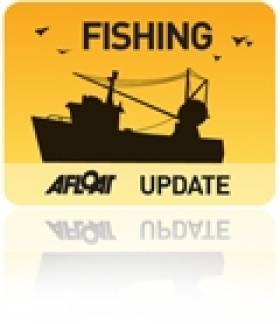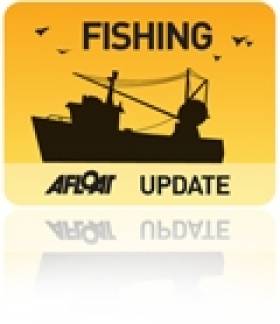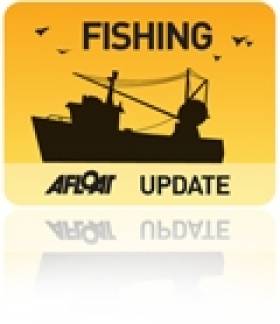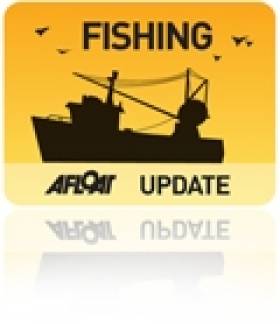Displaying items by tag: BIM
Marine Minister Introduces Conservation Measures Proposed By National Inshore Fisheries Forum
#Fishing - Marine Minister Michael Creed signed into law conservation measures concerning Irish velvet crab stocks as he hosted the 12th meeting of the National Inshore Fisheries Forum (NIFF) today, Wednesday 27 September.
The Inshore Fisheries Forum structures, which include the NIFF and six Regional Inshore Fisheries Forums (RIFFs), were established in 2014 to foster stakeholder-led development of proposals for the inshore fishing sector.
As well as moved to protect Irish velvet crab, the minister also introduced measures to regulate fishing activities affecting Natura 2000 sites at Hook Head and the Saltee Islands.
Regulations signed by Minister Creed today will introduce a Minimum Conservation Reference Size (MCRS) of 65mm for velvet crab that will apply to Irish sea fishing boats from 1 January 2018.
This measure was initially developed by the West Regional Inshore Fisheries Forum (RIFF) with advice from the Marine Institute. The proposal was brought to the minister last year by the NIFF, and a public consultation on the measure was held at the end of 2016.
Velvet crab are fished all year, but mainly in the March to October period, and they are predominantly a by-catch in the lobster fishery. Landings of velvet crab into Ireland were 406 tonnes in 2015, higher than any year since 2004, and were valued at just under €808,000. Over 80% of velvet crabs are landed by vessels less than 10 metres in length.
Additionally, a Fisheries Natura Declaration signed by Minister Creed today will restrict fishing using dredge and trawling gear for scallop fishing to protect certain sensitive habitats in Natura 2000 conservation sites off the southeast coast of Wexford from 30 November.
The Natura 2000 sites include the Hook Head and Saltee Islands SACs (Special Areas of Conservation). The declaration also sets down monitoring and notification requirements for boats fishing using dredge and trawling gear within these habitats.
These gear and monitoring measures were developed through industry members working with the Marine Institute and Bord Iascaigh Mhara (BIM) to address risks to sensitive habitats in the Hook Head and Saltee Islands SACs. The risks were identified by the Marine Institute in a 2014 risk assessment report of sea-fishing activities in Natura 2000 sites in the Irish Sea.
Industry members – including individual scallop fishermen, members of the Southeast RIFF and representatives of the Irish South and East Fish Producers Organisation (ISEFPO) – met with the Marine Institute and BIM through 2015 and 2016 to develop risk mitigation proposals for the fishery. A public consultation on the resulting Mitigation Response Plan was carried out in 2016.
These measures are being introduced following full consultation with the Inshore Fisheries Forum structures.
“Heading into their third year, the forums have taken a lead in tackling conservation issues and changing practices with a view to long-term sustainability,” said Minister Creed. “I welcome the support these measures have received from the Forums which reflects the mature approach this sector is taking in dealing with its own challenges.”
Minister Creed and the NIFF discussed the implementation of the new measures and the status of other measures under review for important stocks such as lobster, brown crab and razor clams.
The minister also discussed the impact of Brexit on the fishing sector and the UK’s intention to withdraw from the London Fisheries Convention, which governs access to waters inside the 12-mile limit.
Commenting on issues arising for the sector from Brexit, Minister Creed noted: “While the implications of Brexit are far from clear at this point in time, I will continue to highlight Irish fisheries concerns on the EU agenda and work with other impacted EU member states and the Barnier team to ensure that fisheries are not isolated in the overall negotiations on a new EU/UK relationship.”
Marine Minister Announces €12M EMFF Funding For Fisheries Action Groups
#Fishing - Marine Minister Michael Creed has announced €12 million funding under the European Maritime and Fisheries Fund (EMFF) Operational Programme for seven Fisheries Local Action Groups (FLAGs) to fund local development initiatives in Ireland’s coastal communities.
The seven new groups – South West (Kerry), West (Galway, Clare), Northwest (Mayo, Sligo), North (Donegal), South (Cork), Northeast (Louth, Meath, Dublin) and Southeast (Wicklow, Wexford, Waterford) – were selected as part of a competitive process under the community led local development element of the €240 million EMFF Operational Programme.
Each FLAG received a sum between €1.5 million and €1.98 million in funding that is 50% financed by the EU.
“This funding will be allocated by and to those communities by the seven FLAGs recently established,” said the minister. “The FLAGs are made up of local actors from the fisheries and aquaculture sectors and others with a strong interest in fostering the development of our coastal communities.
“The funding will be available to the FLAGs over the period 2017 to 2021 approximately and is an eight-fold increase on the €1.5m that was available under the previous FLAG scheme.”
Bord Iascaigh Mhara chief executive Tara McCarthy added: “As the State agency responsible for providing a range of administrative and technical supports to the FLAGs, we welcome the significant increase in funding for a programme that has already contributed €1.5 million in direct and indirect investment to our coastal communities.
“Each of the FLAG groups represents 7 coastal communities where the importance of the Irish Seafood Sector from our fishermen to seafood processors and retailers is paramount. This increase in funding will enable BIM to assist the FLAG groups to develop strategic plans that will enhance and in some cases diversify their existing marine related resource and enterprise.
“On behalf of BIM, I would like to thank all of the FLAG members for their dedication to this programme.”
| FLAG Name | Coastal areas of County | EMFF Allocation |
|---|---|---|
| South West FLAG | Kerry | €1.53 m |
| West FLAG | Galway, Clare | €1.80 m |
| Northwest FLAG | Mayo, Sligo | €1.50 m |
| North FLAG | Donegal | €1.95 m |
| South FLAG | Cork | €1.98 m |
| Northeast FLAG | Louth, Meath, Dublin | €1.56 m |
| Southeast FLAG | Wicklow, Wexford, Waterford | €1.68 m |
| TOTAL | €12 m |
Irish Fisheries Chief Wants To Create A Taboo About Lifejackets
Tara McCarthy has a magnificent view out of her office windows.
“You could look out there all day,” she says as we chat in the office on Crofton Road in Dun Laoghaire, looking out on Dublin Bay. Even on a damp January afternoon it is a great vista as a ship heads out of Dublin Port into what it seems will be a harsh enough time ahead at sea. However, it is not the view we have met to discuss, but whether a taboo can be created around a troubling issue – safety at sea and those who will not wear lifejackets.
Tara McCarthy is Chief Executive of Bord Iascaigh Mhara, the State fisheries board, which has launched a campaign to persuade fishermen that they must wear lifejackets. There has been an attitude amongst them that it was better not to wear one. If a fisherman fell into the sea from the boat, it was likely that the sea would take him, so it was better not to struggle to live.
That was the attitude, about which a taboo would be in place if Tara McCarthy has her way.
The statistics are frightening. Fishing is thirteen times more dangerous than the construction industry. Over the last ten years 53 fishermen have lost their lives at sea. BIM research showed that quite a number of fishermen knew colleagues who died at sea but many of those fishermen, even though they knew a colleague who had died in a tragedy, would still not wear a lifejacket.
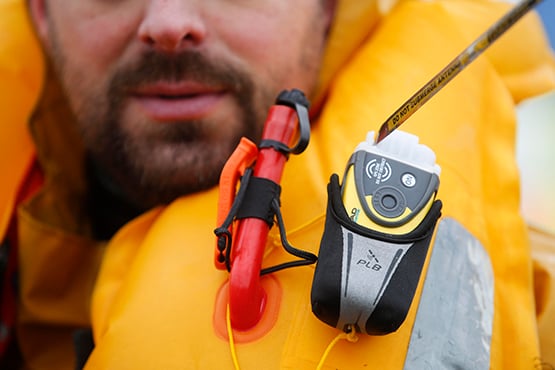
The new BIM lifejacket with built-in position finder
That shocked me and so it did the CEO also, which is why the lifejackets campaign is tough, hard-hitting.
“Those fishermen should realise the impact they could have on their families by a decision not to wear a lifejacket. It is, perhaps, shocking to face them with that realisation but we have launched a campaign that is deliberately hard-hitting campaign. “It is not soft, just saying that it would be nice to wear a lifejacket. We are facing fishermen with a life-impacting decision. We talked to fishermen about this and they told us to make it hard-hitting and that is what we are doing.”
• Listen to the BIM CEO on the programme above
Galway Bay Fish Farm Plans Withdrawn
#FishFarm - Bord Iascaigh Mhara (BIM) has withdrawn the application for its controversial fish farm proposal for the Aran Islands ahead of new plans to limit the size of aquaculture projects.
As the Irish Examiner reports, campaigners against the ambitious 500-hectare, 15,000 tonne organic salmon farm for Galway Bay have welcomed the decision by BIM to rethink its development in line with a new national strategic plan that will limit fish farms to under 7,000 tonnes.
BIM's application has been with the Department of the Marine for more than three years, with Marine Minister Simon Coveney saying this past March that he would not be drawn on any timeframe for a decision to approve what would have been the largest such fish farm in Europe.
The application has long faced opposition from local angling and environmental groups, as well as concerns from the EU over its environmental impact.
This past summer controversy arose again as campaigners blasted BIM for spending thousands of euro on PR on the project, that would have seen Ireland attempt to overtake Scotland as a leading producer of organic salmon.
The Irish Examiner has more on the story HERE.
Dubliner is Young Fishmonger of the Year
A Dublin Fishmonger with three retail outlets has been declared Ireland’s Young Fishmonger of the Year. George Stephens of The Fish Market in Blanchardstown was declared the winner at the final held in Kinsale last night. He told Tom MacSweeney why he liked being a fishmonger in an interview above.
Stephens also has retail outlets in Maynooth, Co.Kildare and in Mullingar Town. A professional chef with eight years’ seafood retail experience, he works with his wife and business partner Anne, developing new ready-to-go seafood products and has recently launched a new range of freshly fried fish in his Blanchardstown store.
The competition, run by Bord Iascaigh Mhara, was extensively judged over the past two months by a team of judges assembled by the board. This included practical skills and business testing.
This is the third year of the competition and the award was presented at television personality Martin Shanahan’s restaurant, Fishy Fishy, in Kinsale.
Tara McCarthy, Chief Executive of BIM, said the competition is intended to encourage young people to seek careers in the seafood industry.
George Stephens received a specially designed trophy, a study trip to France and a cheque for €1,000
An Bord Iascaigh Mhara (BIM) Seek New Chief Executive
#fishing – BIM, the Irish Sea Fisheries Board, are seeking a person with a record of success as a leader, preferably in the marine sector, to become its Chief Executive. The post is advertised in this morning's Irish Times newspaper. The post is based at BIM's Head Office in Dun Laoghaire. A copy of the advert is downloadable below as a jpeg file.
BIM Seeks Members for Regional Inshore Fisheries Forums
#inshorefisheries – Following the launch of the National Inshore Fisheries Forum (NIFF) earlier this year by the Minister for Agriculture, Food and Marine, Mr. Simon Coveney T.D. and the recent agreement on the terms of reference for the forum; BIM are now seeking members to take part in the Regional Inshore Fisheries Forums (RIFFs). Each RIFF will feed into the National Inshore Fisheries Forum and will link with the existing infrastructure of the Fisheries Local Action Groups or FLAG's programme. There are six FLAG's established in coastal regions around Ireland.
The RIFFs will comprise of no more than 12 members.
A minimum of 8 members will represent the inshore fisheries sector and will be appointed on the basis of:
their ability to represent the views of the inshore sector
their knowledge of inshore fisheries, fish stocks, and fishing methods, and
their capacity to engage on fisheries management issues.
In addition, the FLAG will aim to ensure that the membership is representative of the FLAG region's geographical coverage and the characteristics of the region's inshore fleet and fisheries. Applicants must demonstrate support within their respective sector for their nomination to a forum. The balance of the membership will include stakeholders from marine sectors other than fisheries, such as seafood processing/sales, marine leisure, marine tourism, environmental NGOs and community organisations.
Should the FLAGs consider a sector or area is lacking in representation the FLAG reserves the right to approach appropriate individuals or organisations to seek members.
If you are interested in applying for membership of the RIFFs, please e-mail Caroline Curraoin in BIM [email protected] or send your application by post to FLAG Co-ordinator, BIM, , P.O. Box 12, Crofton Rd., Dun Laoghaire , Co. Dublin. Full details on the terms of reference for the National Inshore Fisheries Forum are available on www.bim.ie
The closing date for all applications is Friday, 29th August 2014.
#Seafood - Just days after his resignation as CEO of Bord Iascaigh Mhara (BIM), Jason Whooley has been announced as the chief executive of Bio-marine Ingredients Ireland, as OceanFM reports.
The new body, a joint venture between the Killybegs Fishermen’s Organisation and Norwegian firm Biomarine Science Technology, is behind the "game-changer" €35 million project in the Donegal fishery harbour that's expected to create 50 construction jobs and a further 70 direct and indirect positions once operational.
As previously reported on Afloat.ie, the new scheme - promoted by the development of the new boarfish fishery - is set to be the largest marine food ingredients plants in the world when it enters its first full year of production in 2017.
#FishFarm - Bord Iascaigh Mhara (BIM) has responded to concerns from environmental groups that an ingredient in treatments for sea lice in salmon farms poses a threat to wild marine life.
As Galway Bay FM reports, campaigners Galway Bay Against Salmon Cages - one of the groups opposed to the planned Galway Bay fish farm - say that cypermethrin, an active ingredient in veterinary medicine used to treat sea lice, is toxic to aquatic organisms.
BIM aquaculture manager Donal Maguire attempted to play down fears over the use of the pesticide, saying it has been fully tested for toxicology in the marine environment.
However, another campaign group claims BIM's position is contrary to the manufacturer's own warnings on the use of the drug.
According to FishNews.eu, Friends of the Irish Environment (FIE) cited the Irish Medicines Board's product description for cypermethrin, which states that it is "dangerous to fish and other aquatic life" and demands that the chemical "should not be allowed to contaminate water".
FIE went on to describe cypermethrin as "a biocide which kills life, not a medicine that saves lives" and as "a highly active neurotoxin" with "known effects on fish and, most sensitive of all, crustaceans such as crabs and lobsters. Bathers and watersports [enthusiasts] may also be at risk."
Earlier this month, Inland Fisheries Ireland (IFI) expressed "serious concerns" over the findings of a study on wild salmon in Ireland that claimed fish farm schemes were less harmful to wild fish than pollution and possibly even beneficial to wild catchments.
IFI is among the significant opposition to BIM's proposed organic salmon farm off the Aran Islands, a 500-hectare project that would be the largest of its kind in Europe and create hundreds of jobs in the locality.
#Fishing - The Irish Times reports that Inland Fisheries Ireland (IFI) has expressed "serious concerns" over the findings of a new study on wild salmon in Ireland.
The State agency for Ireland's fisheries argues that the study - which concluded not only that pollution has a greater impact on wild salmon numbers than fish farming, but also that salmon catchments in close proximity to aquaculture schemes were some of the best performing - is based on flawed methodology.
IFI is among the chorus of voices opposed to the planned organic salmon farm off the Aran Islands in Galway Bay - a 500-hectare project by Bord Iascaigh Mhara (BIM) that would be the largest of its kind in Europe if given the go-ahead.
Marine Minister Simon Coveney recently attempted to alleviate concerns over the controversial scheme, claiming there would be no damage to the environment or fish stocks.
However, the controversy doesn't end there, as last month celebrity chef and 'Slow Food' champion Darina Allen wrote to the minister over erroneous claims in BIM's environmental impact statement (EIS) for the project.
As reported by the Galway Independent, Allen contacted Minister Coveney to clarify that the Slow Food movement does not support fish farming projects, after references to the initiative in the EIS "seemed to create a lot of confusion".
Allen told the paper: “Many people contacted me under the perception that Slow Food endorsed the whole salmon farm thing and actually Slow Food has made no statement whatsoever on it.”
Later, Michèle Mesmain of Slow Food International confirmed that “salmon farming does not fit in any pillar of Slow Food”.
The Galway Independent has much more on the story HERE.




























